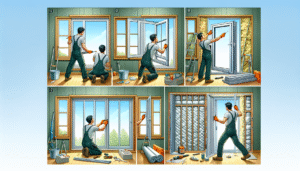
How to seal aluminum windows?
Aluminum windows are tough, but poor sealing can let in air and water, causing discomfort and energy loss. Luckily, sealing is possible and easier than you might think.
You can successfully seal aluminum windows by using the right materials and following a few simple steps. Proper sealing prevents drafts, leaks, and energy loss—making windows more efficient and comfortable.
If you’re a homeowner, contractor, or window dealer, understanding how to seal aluminum windows will make a difference in performance, bills, and comfort. Let’s look at how it’s done—step by step, with tips for every level of experience.
Can you seal aluminum windows?
Drafts and water leaks can turn any window into a weak spot—but aluminum windows are far from hopeless.
Yes, you can seal aluminum windows. These windows are strong, but need proper sealing to prevent air and water infiltration. Both new installations and older windows can be effectively sealed for better efficiency.
Why is it necessary, and how does it help?
Aluminum windows are popular for their durability, low maintenance, and modern look. But gaps—either from aging, poor installation, or coastal corrosion—can lead to drafts and leaks. Sealing is crucial for:
| Reason | Result |
|---|---|
| Energy efficiency1 | Less heat/cool air escapes, lowering utility bills |
| Comfort | Prevents cold/hot drafts and outdoor noise |
| Water protection2 | Stops leaks and prevents mold or frame rot |
| Longevity | Extends life of the whole window unit |
HOGLAD windows are designed with sealing in mind—frames have clean lines and room for sealants or weatherstripping, making installation and repainting easy. Whether you’re doing a quick DIY job or hiring a pro, sealing is always worth it.
What is the best sealant for aluminium windows?
No two sealants are made equal—using the wrong one can cause messy failures.
The best sealants for aluminum windows are neutral-cure silicone, polyurethane, and siliconized latex caulk. Each provides water resistance and flexibility. Choose based on indoor/outdoor use, paintability, and gap size.
How do you choose the right one?
There are a few top performers for aluminum windows:
| Sealant Type | Best For | Paintable? | Key Feature |
|---|---|---|---|
| Neutral-cure silicone3 | Frame, glass, caulk joints | No | Flexible, UV-proof, color choices |
| Polyurethane4 | Large or exterior gaps | No | Tough, weather-resistant |
| Siliconized latex caulk | Aesthetic/indoor finishing | Yes | Paintable, easy to smooth |
Always use backer rod for gaps wider than 1/4" and look for weather-resistant options in harsh climates. At HOGLAD, we recommend proven brands and specs for every window install—reach out anytime, and we’ll match you with the right sealant.
Can aluminium windows be resealed?
Seals don’t last forever—wind, sun, and time all take their toll.
Yes, aluminum windows can be resealed. Remove old caulk or gaskets, clean the area, and apply new sealant. This quick maintenance step can drastically improve efficiency and prevent leaks.
What’s the step-by-step process?
Resealing is a straightforward fix if you follow these steps:
| Step | What to Do |
|---|---|
| 1. Remove old sealant | Use a utility knife or scraper to clear worn-out caulk/gaskets |
| 2. Clean the area | Use alcohol cleaners for a residue-free, dry surface |
| 3. Choose sealant type5 | Match product to gap size/material (see previous table) |
| 4. Apply new sealant6 | Use a caulking gun at a 45° angle for even coverage |
| 5. Smooth and inspect | Smooth out with a wet finger or spatula, check corners for gaps |
In special cases (like severely broken glass or corroded frames), replacement may be required—but most aluminum windows benefit from a proper reseal. At HOGLAD, we offer maintenance guides for our products, so no one’s left guessing.
How to air seal aluminum windows?
It’s not just about water—unsealed windows let air in, driving up bills and letting in noise.
Air sealing aluminum windows involves finding leak points, cleaning, and applying flexible sealants or weatherstripping indoors and out. Rope caulk, magnetic strips, or silicone maximize airtightness.
What are the best methods for airtight results?
Airtight windows7 keep out wind and noise. Here’s how to get there:
| Step | Key Points |
|---|---|
| 1. Detect leaks8 | Use a candle/smoke stick or IR thermometer for cold spots |
| 2. Prep surfaces | Clean thoroughly—remove dust, old caulk, and dry the frame |
| 3. Outer seal | Apply silicone or polyurethane outside, smooth with spatula |
| 4. Inner seal | Use paintable latex, rope caulk, or V-strips for sashes |
| 5. Sliding tracks | Place rope caulk or magnetic seals on sashes and corners |
Remember: Don’t seal in wet or freezing weather, and check your work from both inside and outside. HOGLAD windows often have slots or pre-flattened surfaces for faster, easier air sealing. And don’t forget to test with the candle method to confirm results.
Conclusion
With the right products and a careful approach, aluminum windows can be sealed or resealed for long-term comfort and energy savings—no special expertise needed.
-
Exploring this link will provide insights into how energy efficiency can save you money and enhance comfort in your home. ↩
-
This resource will explain the importance of water protection in windows, helping you understand how to maintain your home effectively. ↩
-
Discover the advantages of Neutral-cure silicone sealant for your projects, including flexibility and UV resistance. ↩
-
Learn why Polyurethane sealant is ideal for large gaps and its weather-resistant properties. ↩
-
Understanding the right sealant type is crucial for effective resealing, ensuring durability and performance. ↩
-
Learning the correct application technique can significantly enhance the seal's effectiveness and longevity. ↩
-
Exploring this link will provide insights into the advantages of airtight windows, enhancing your understanding of their importance. ↩
-
This resource will offer detailed methods and tools for leak detection, ensuring your sealing efforts are effective. ↩
You may also be interested in:

How to remove aluminum windows?
Struggling with hard-to-remove aluminum windows wastes precious time and jeopardizes your renovation results. Learning the right approach will save effort, prevent costly mistakes, and protect your property. To remove aluminum

How to replace aluminum windows?
Are your aluminum windows drafty, stuck, or just looking tired? Learn the steps, the options, and the tips you need to make a smooth upgrade—whether you DIY or hire help.

How long do aluminum windows last?
Every window has an expiration date—even premium aluminum windows. The trick is understanding how long they truly last, so you can plan replacements and avoid costly surprises. Aluminum windows typically

Hi there! I'm Thea, mom and hero to an adorable 5-year-old boy. By day, I'm a seasoned pro with 10 years in the window and door industry, going from sales to owning my own factory. Here to share what I've learned—let's grow together!
Contact with me
No-nonsense Guide for Newbies
- ✔Master mold basics quickly
- ✔Avoid costly beginner mistakes
- ✔Gain industry-ready insights
- ✔Boost technical understanding
- ✔Accelerate business growth
